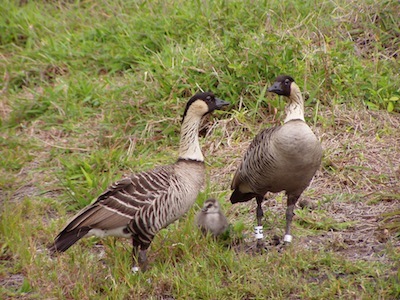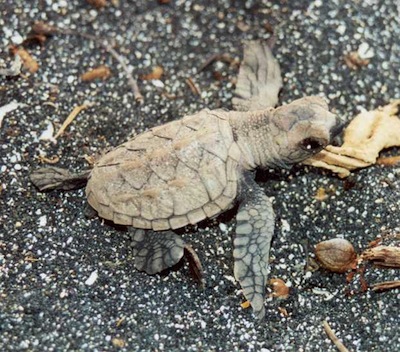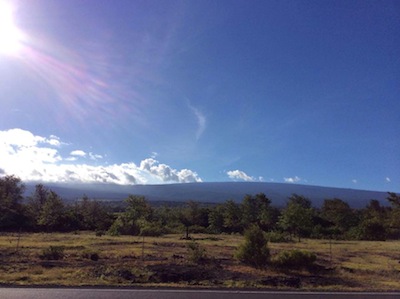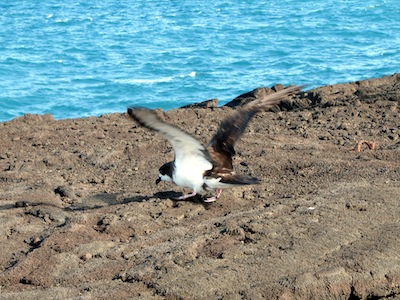
Native wildlife at risk at Hawai’i Volcanoes
The Hawaiian Islands are the most geographically remote archipelago on the planet, making it the home of an impressive amount of unique animal and plant inhabitants. However, many of these native species have become endangered.
At the Hawai’i Volcanoes National Park, a park located in Hawaii, 59 threatened plants and animals are federally listed as threatened.
| Click on the video at the right to view an audio slide show about endangered species at Hawai’i Volcanoes National Park prepared by writer Nicole Lopez-Alvar. |
About 70 million years ago, these unique organisms made their way to these remote volcanic islands and found ways to evolve off the nutrients of the eruptive land. Native species of these islands include giant dragonflies, carnivorous caterpillars, and exotic birds. However, due to invasive species, bird malaria and habitat intrusion, Hawaii’s native wildlife is endangered and threatened.
The National Park Service is working to eliminate this high number of endangered species, but the park can only actively monitor and protect five out of the 59 species that it identifies as flagship species. These species include the hawksbill turtle, Hawaiian petrel, Hawaiian goose, Mauna Loa silversword plant and the rare plants that belong to the lobelia family that were added to the list of flagship species in 2010.
Rhonda Loh, chief of Natural Resources Management at the Hawai’i Volcanoes National Park, stated that “flagship species and are used in interpretive media to highlight the plight of the many endangered and rare species in the park, and park staff efforts to protect them.”
 |
At left, two three-year-old female and male Hawaiian geese with their first-born gosling.Below, a Hawksbill turtle hatchling walking towards the shore of the Island of Hawaii (Photos courtesy of Rhonda Loh). |
By giving a spotlight to these species, the National Park Service hopes to make the public aware of the severity of the situation.
According to Loh, efforts to protect individuals and populations rely on a wide range of actions. These include fencing the park to exclude large introduced herbivores (cattle, goats, sheep and pigs), invasive plant control, predator control, monitoring and researching limiting factors, reintroduction of native species, education, and outreach.
For a large number of listed plants, exclusion of herbivores is followed by propagation and planting of individuals to re-establish species into their former range. This is especially true for the highly endangered lobelia family of plants.
 These efforts are not infiltrated without a price, which is why the park relies on its many partners for financial support and backing as well as the National Park Service.
These efforts are not infiltrated without a price, which is why the park relies on its many partners for financial support and backing as well as the National Park Service.
“Funding for these actions comes from a variety of sources, including internal National Park Service fund sources, U.S. Fish and Wildlife, World Turtle Trust, National Fish and Wildlife Foundation, and others,” stated Loh.
“The park’s large number of federally listed species is reflective of the overall high number of listed species in the State of Hawaii, said Loh. “Approximately 27 percent of federally listed species in the U.S. are located in the State of Hawaii.”
According to Loh, factors that contribute to this high number of endangered species include: “The high rate of endemism, or species unique to the islands, that are found no where else in the world- a product of millions of years of speciation in a very remote geographically isolated archipelago; habitat destruction by humans and introduced plants and animals; competition, predation, herbivore and disease caused by introduced plants, animals and organisms.”
Efforts to protect these species from being extinct do not end here.
Partners of the Hawaii Volcanoes National Park, Friends of Hawai’i Volcanoes National Park (FHVNP), is a non-profit organization that is supporting the National Park Service’s efforts to protect and preserve the natural and cultural resources of the Hawai’i Volcanoes National Park.
Elizabeth Fien, the Education and Outreach coordinator of the organization, further explained their mission statement.
“We envision a park with a cultural and natural native ecosystem where all visitors experience a profound connection to the unique physical and spiritual beauty of the Island,” said Fien. “We hope by drawing awareness to the beautiful species that inhabit the Island, they will see the importance of protecting them. Some of the endangered species include the nene and the hawksbill turtle — all unique and nonthreatening animals that deserve the chance to prosper and survive in their own natural habitat.”
 |
At left, the volcano Mauna Loa (Photo courtesy of Elizabeth Fien of Friends of Hawaii Volcanoes National Park). Below, an Hawaiian petrel being released after being found grounded and disoriented by artificial lights (Photo courtesy of Rhonda Loh). |
Ab Valencia, office administrator at the Friends of Hawaii Volcanoes National Park, stated his concern about the invasive species that have taken over the island. “Since they are ongoing threats, our priority is to maintain them outside of the boarders of the park. That way, we can slowly remove of these invasive species permanently,” said Valencia.
“Among these intruders are feral cats, pigs, goats, sheep, rats, mongoose and coqui frogs. At the Hawaii Volcanoes National Park, the invasive coqui frog poses as a constant threat since they are easily transportable to and from the park by accident. These reasons and more are why we must do all we can to preserve this unique park.”
Hawai‘i Volcanoes National Park is unique for its multi terrain and ever evolving ecosystem that is unlike any other park. It is a terrain designed by nature for more than 70 million years. From volcanic activity, migration of species, and evolution, the land adapts to its surroundings and its surroundings adapts to the park — making the park an ecosystem of itself.
 The Hawaii Volcanoes National Park does not only contain two of the world’s most active volcanoes, but it bares an environment of native species that have learned to adapt over centuries to the eruptive land, and do not plan on leaving quite yet. It is a park that must be seen in person to believe, and a park that is in need of attention.
The Hawaii Volcanoes National Park does not only contain two of the world’s most active volcanoes, but it bares an environment of native species that have learned to adapt over centuries to the eruptive land, and do not plan on leaving quite yet. It is a park that must be seen in person to believe, and a park that is in need of attention.
For more information on how to contribute to the efforts of the Hawaii Volcanoes National Park and its funding partners, or if you are planning your visit to the extraordinary park, you can visit:
- the National Park Service website http://www.nps.gov/havo/index.htm
- the Friends of Hawai’i Volcanoes National Park website, http://www.fhvnp.org
- the Hawai’i Pacific Parks website at http://www.hawaiipacificparks.org.
For questions, inquiries or concerns about the park, you can reach the Hawai’i Volcanoes National Park main phone at 808-985-6000.

Comments are Closed